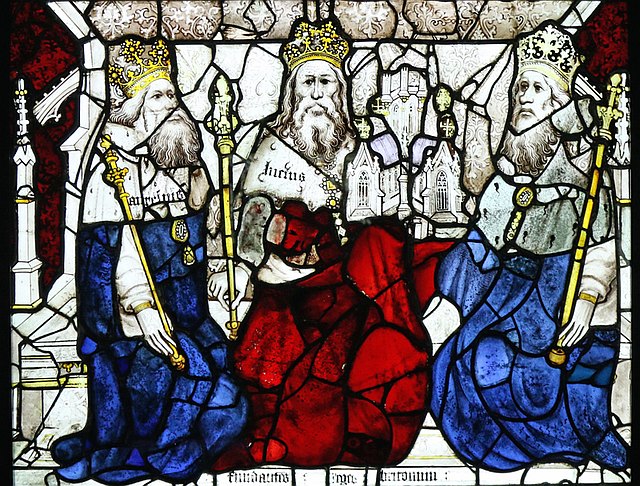

As mentioned in Issue No. 204, we are informed by St. Bede that in the reign of Marcus Antoninus Verus and Aurelius Commodus, a Briton King named Lucius sent a letter to Pope St. Eleutherius, entreating that, by his direction, he and his subjects might be made Christians. This must have happened about the year 182. Lucius must have reigned in some part of Briton subject to the Romans, as his Latin name indicates. That St. Lucius was a Christian King in Briton is proved by two coins mentioned by Usher (Antiq. Brit. c. 3 p. 22), and one by Bouterue. St. Bede tells us that by his embassy to St. Eleutherius, he obtained the effect of his pious request; and that the Britons enjoyed the light of Faith in peace until the reign of Diocletian. St. Lucius was therefore the first Christian King in Europe; but it nowhere appears in what part of Britain he reigned. The records of Glastonbury Abbey tell us that St. Eleutherius sent over to Britain Ss. Fugatius and Damianus (also called Dumianus, Duvianus, or Deruvian), who baptized King Lucius and many others, and were buried at Glastonbury (in southwest England. The image above is from an ancient stained glass window in the cathedral of York.)
The Christian Faith had reached Britain even in the times of the Apostles. Pope St. Clement I affirms that St. Paul
preached to the utmost bounds of the West. Gildas says the first dawn of the evangelical light appeared in this island about the
eighth year of Nero. Theodoret names the Britons as a nation in which St. Paul sowed the seeds of Faith, and in another place says
that this Apostle brought salvation to the islands that lie in the ocean. Three Briton bishops assisted at the Council of Arles in 314;
again, certain Briton bishops subscribed to the Council of Nicaea against the Arians. The testimonies of St. Justin, St. Irenaeus,
Tertullian, Eusebius, St. Chrysostom and Theodoret demonstrate that Christianity had got a footing in Britain very soon after the
time of Christ. We cannot, therefore, wonder that a prince should have embraced the Faith in Britain in the second century; nor do the
objections which some have raised deserve notice. Schelstrate, the learned Prefect of the Vatican Library, in his dissertation on the
Patriarchal authority, transcribes the following words from an ancient manuscript history of the Kings of England: Lucius sent a
letter to Pope Eleutherius that he might be made a Christian, and he obtained his request.
The same learned author copies the
following testimony from an ancient catalogue of the Popes, written in the time of the Emperor Justinian, as we are assured by the title,
found in the Library of Christina, Queen of Sweden: Eleutherius received a letter from Lucius, King of Britain, who desired to be
made a Christian by his command.

We are told by many Bavarian and German historians that King Lucius, resigning his kingdom, preached the Faith – first at
Noricum (Austria) and Vindelicia (Southern Germany / Bavaria), principally at Augsburg, and then being banished thence,
in Rhaetia (Switzerland), especially at Chur (known as Switzerland's oldest city
). But some are uncertain who
that St. Lucius was – whether the 2nd century King or a missionary of a later age, perhaps the 5th or 6th century. Nonetheless the
Roman Martyrology identifies him with St. Lucius the King. In Chur, St. Lucius has been honored as the founder of the church there,
and one of the first apostles of that place. Some even say that he was admitted to Holy Orders and became the first Bishop of Chur –
his name appears first on an ancient list of the Bishops of Chur. It is also said that whilst he preached among the Grisons
(the people of that part of Rhaetia), storms raised by the infidels obliged him to fly into a deserted place and there lie
concealed on a hill which is called, in the local dialect, Sankt Luzisteig (Hill or Path of St. Luzius, image above).
He afterwards retired into a nearby cave. At length he is said to have fallen into the hands of the persecutors, and been condemned
to death by the Roman lieutenant of the province, and beheaded in the fortress of Martiola (Marzola ?) toward the latter end
of the second century. There stands an ancient monastery of St. Lucius in Chur (later it became a seminary), and his feast is
kept in that diocese with great solemnity. His relics were chiefly relocated to the Cathedral of Chur, which has been dedicated to
the Assumption of the Blessed Virgin Mary, at least since the 13th century.
Alphabetical Index; Calendar List of Saints
Contact us: smr@salvemariaregina.info
Visit also: www.marienfried.com